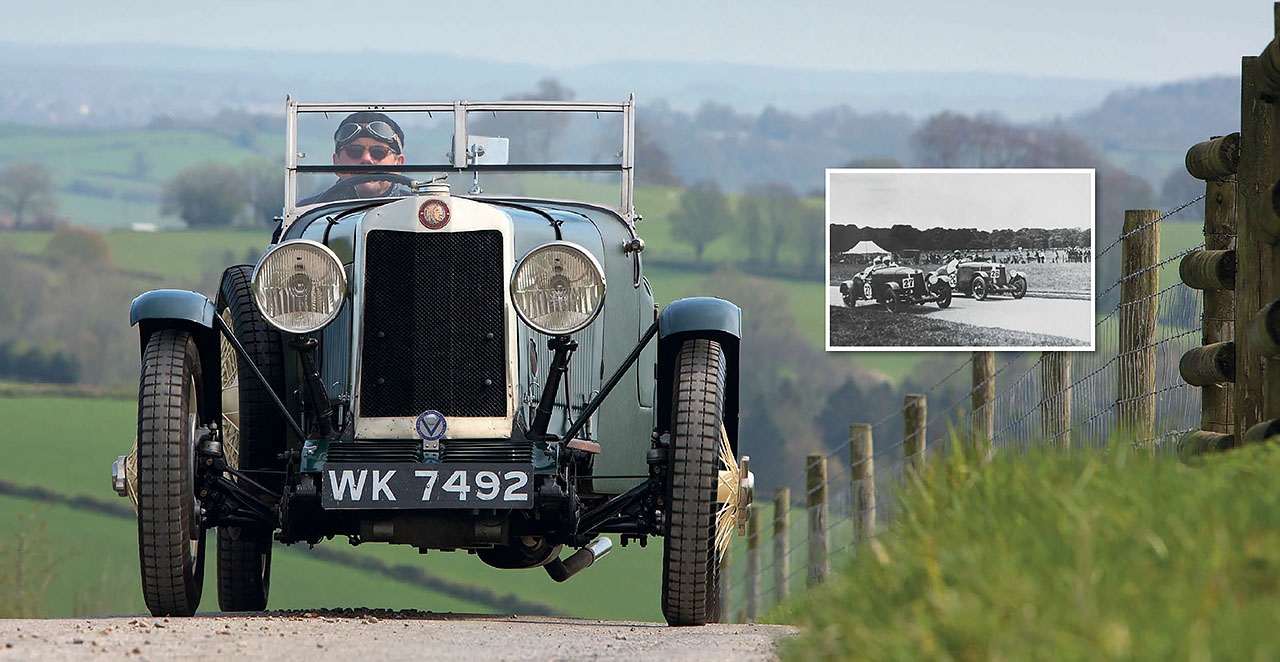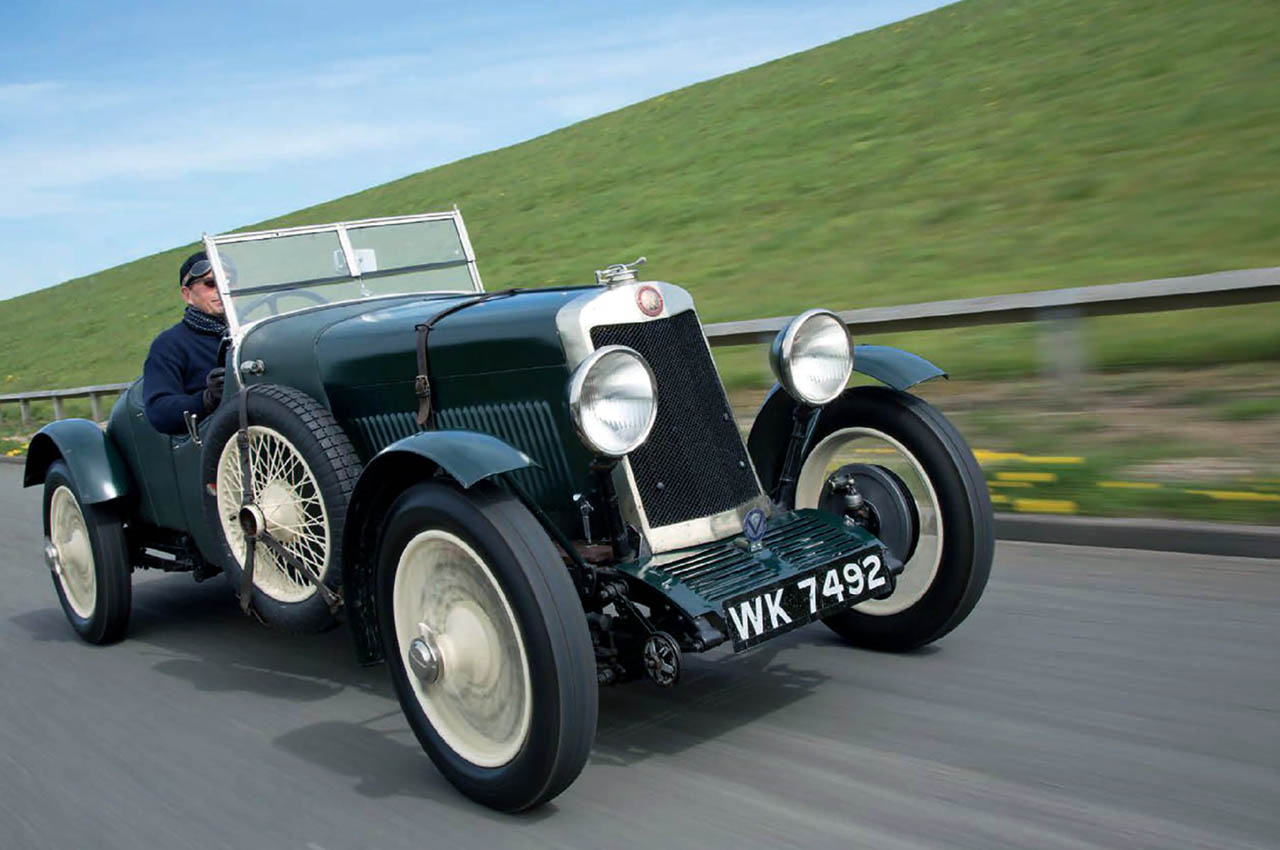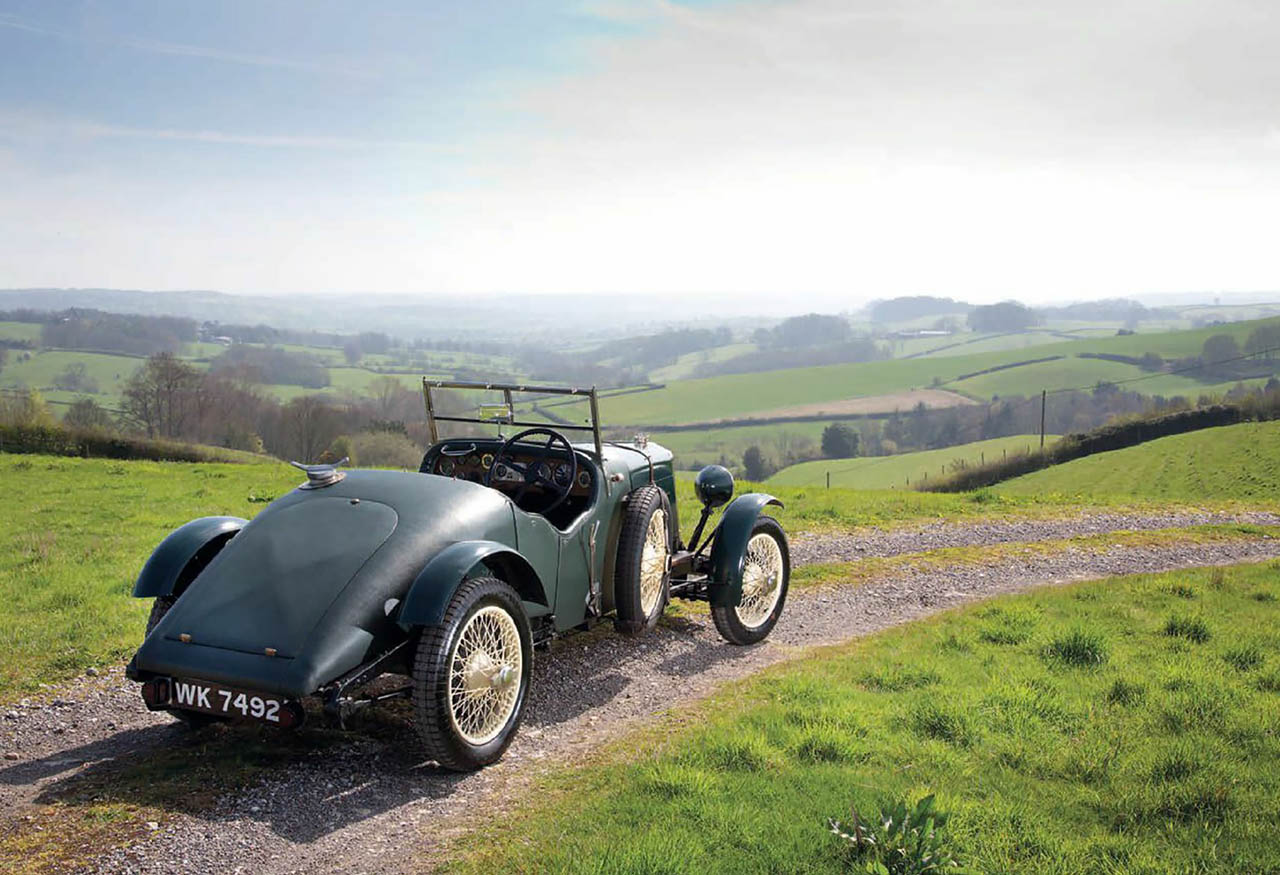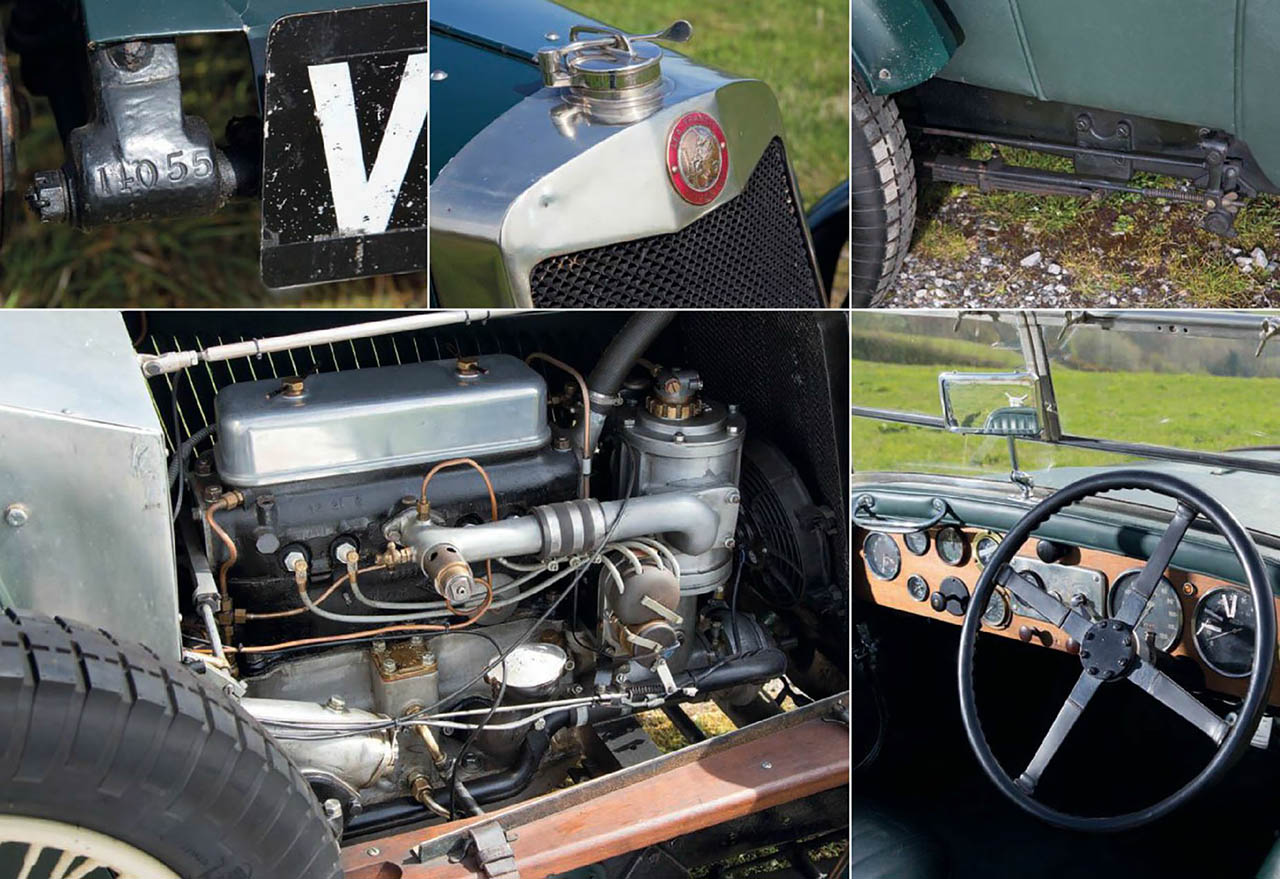
Ultimate Lea-Francis On the road in TT Hyper. Green’s British Racer Lea-Francis heirloom. The family Hyper with TT pedigree. The Lea-Francis Hyper shone on the 1928 TT, says Mick Walsh as he samples the team car driven by Wilf Green and now owned by his son, historics racer Willie. Photography John Colley/LAT.
The S-Type’s purposeful shape looks best when viewed from the front. Inset: Wilf Green passes his teammate en route to fifth in the 1929 Irish GP. The Lea-Francis may look upright compared to rivals such as a Chain Gang Frazer Nash, but feels no less sporting to drive.
Many enthusiasts get nostalgic about vehicles owned by their fathers, but the connection with this rare vintage sports car goes back long before historics ace Willie Green was born. His father Wilf was an industrious Derby milliner who raced at Brooklands as a hobby for several manufacturers including Austin and Alvis, but his strongest links were with Lea-Francis in the late 1920s.

During Green’s childhood, his father was focused on work and rarely talked about those early racing days, but as Willie’s competition career developed (against his parents’ wishes), he started to investigate. “My father kept a few pictures and a fascinating TT lap chart, but in later years he wasn’t bothered about motorsport,” he recalls. “Dad was a shy character and away a lot on business.” As his own racing focused on historics, so Green became intrigued by the cars that his father had driven, particularly the supercharged S-Type (or Hyper) with which he had competed in Tourist Trophy events as a works driver: “From the lap charts, I discovered that father was always quick but kept to strict rev limits to save the car. An old boy at the factory told me that Dad insisted on building his own engines, and used to run them in on a lathe.”
His father’s 1928 team car, chassis 14055, had long since disappeared, so Green acquired a pair of road models and, with the help of Cameron Millar, even built a replica of the lightweight TT model. Then, in 1993, came the exciting news that Wilf Green’s old racer, one of the victorious team, had been discovered in a lock-up on a caravan park near Bracknell: “My father had kept the Hyper after the TT, and continued competing at Brooklands and other local speed events. He was also closely involved with the early plans for Donington with Fred Craner. His Hyper was the first car to lap the new local circuit in October 1931, but that was the last record we had of it.”
It was a surprise phonecall from an elderly lady to James Knight at Bonhams that led to WK 7492’s discovery. She knew little about the car but her late husband, who’d bought it for £50 in 1956, had told her that its sale might help her in old age. After problems with the blown Meadows engine, the Hyper had been put into storage, remaining there for the next three decades. Story has it that glamour magazines were found in the car because the owner used it as a secret retreat.
Complete but needing a full restoration, the barn-find was the talk of Bonhams’ Earls Court Motor Show auction in October 1993. The Green family was thrilled by the discovery and, although determined to re-acquire the old racer, planned to keep a low profile. “We had my niece Katie bidding at the back because I refused to register, so concealing our interest,” Green reveals. “Using a signal system but no paddle, we kept Robert Brooks sweating after he took the winning bid of £27,000 from the mystery girl at the back. With the car secured, we agreed that the news could be announced. The widow couldn’t believe the price because she was expecting only £1000.”
Willie and his brother Nicholas set about sympathetically restoring WK 7492. The body and frame were complete, although the tail had been shortened. The engine and Cozette vanetype supercharger were dispatched to Meadows specialist Blakeney Motorsport, where the original roller crank and crankcase were replaced with a plain bearing design for reliability.
The chassis was rebuilt by Willie in his home workshop: “It was pretty dilapidated after 30 years in storage, but totally complete because, thankfully, no one had started work on it. Dear old Tom Delaney, who owned the 1928 TT winner, helped to guide the restoration, allowing access to his car and period photos. We made a few mods, including switching to a right-hand throttle, and I took a few leaves out of the rear springs to improve the ride. The quality design of these vintage LeaFs has always impressed me. There was immense pride at the Lower Ford Street factory, and the Hypers were quick, with 100mph speeds at Brooklands. I’ve had this one up to 80mph but the brakes are its biggest weakness.”
The restoration and testing were completed around the Derbyshire roads where Wilf had probably driven the car in the late ’20s. For the 75th anniversary of the Ards TT, the brothers took the car back to Ireland for a run on the course where their father had twice competed.
Reunited with Kaye Don’s winning LeaF, brought over by Delaney (who had witnessed the race from the pits), and driving in the wheeltracks of their father was an emotional trip for all. The car has also been back to Donington for demos on the circuit where it first ran when the layout was exclusively a motorcycle venue.

Distinctive flowing rear was reinstated during Green’s restoration of the Hyper – as discovered in 1993, the car featured a truncated Kamm-tail.
As someone who was also indoctrinated to the Coventry marque during childhood (through my father’s ownership of a 14hp Sports), the supercharged team cars represented the most exotic LeaF produced. Watching the likes of Jeremy Brewster beating Bugattis in Vintage Sports-Car Club events spurred on an ambition to drive one, and meeting up with Green provided the perfect opportunity. Even with such high expectations, the Hyper didn’t disappoint. The way in is from the passenger side, where a handy footplate makes it easier to climb onto the seat and feed your legs under the broad, four-spoke- wheel. There’s a commanding view ahead, and the tall ’screen offers good protection from the chilly spring breeze. The wooden dash features an impressive array of gauges including bold Jaeger rev counter and that distracting boost gauge. Green reckons that the gearing is good for 70mph at 3300rpm. The lever is located on the right (inside the bodywork), with a conventional H-gate but a spring release for reverse, which is found through the slot for first. “It’s slow when cold, but a treat once warmed up,” he advises.
With magneto and fuel pumps on, the gutsy Meadows ‘four’ needs a little choke when cold but soon settles down to a busy burble. Your first impression is the limited lock of the steering, but once on the road the worm-and-wheel’s sharp action is precise, light and inspiring. With the blower driven off the nose of the crank and primed by a modified SU, the motor has urgent, lively torque from low revs. Matched to the close ratios of the superb transmission, the keen performance is clear within a few miles. I quickly appreciate the enthusiastic comments of the LeaF’s top driver Kaye Don, who rated it as ‘a match for any continental sports car in its class’.
The Hyper’s light weight (about 19cwt) aids acceleration through the closely stacked gears, and it’s soon whistling along at the legal limit on rolling back roads. Only the small drum brakes discourage me from fully exploring its impressive pace. It leans a little through corners, no doubt down to the removal of those leaves from the long semi-elliptic rear springs, but the ride benefits from the softer set-up. The leaves would go back if I were lucky enough to own this captivating machine, though, the sharper handling better matched to the superb turn-in and the engine’s eager delivery. The Meadows unit loves to rev – even without the original roller crank – and, at full 15psi boost, the team cars gave about 75bhp at 4500rpm. After a spirited run chasing Green’s modern VW, it is easier to appreciate how Don maintained an impressive 64mph average around the rough Ards circuit.
The Hyper’s finest hour was the Tourist Trophy in August 1928. The fixture attracted a fantastic international entry of 44 cars for the 410-mile challenge around the road course near Belfast. The Coventry outfit developed a lightweight model for the race, with functional fabric bodywork by Cross & Ellis on the four team cars.
A complex handicap matched five classes, ranging from works Austin Sevens to the fastest big-bore men headed by Tim Birkin’s privately entered 4½ Litre Bentley. Other contenders included Austro-Daimlers, a trio of Bugattis and Thomas ‘Scrap’ Thistlethwayte’s 6.8-litre Mercedes 36/220S, which set the fastest lap at 74.39mph.

Clockwise: huge wheel dominates cabin; blown Meadows engine; chassis number on dumb-irons; quick-release radiator cap; brakes are rod operated.
The specially prepared Hypers were entrusted to a crack line-up, with George Eyston and Kaye Don joining factory test-driver Ronald ‘Soapy’ Sutton and SH Newsome, with Wilf Green as reserve. The class opposition looked daunting, Alvis running three independently sprung frontdrive machines for Major Harvey, Leon Cushman and HW Purdy, while a trio of Meadows-engined Frazer Nashes was entered for HJ ‘Aldy’ Aldington, plus Ross and Richard Plunket-Greene.
Prior to the race, the Lea-Francis team had a near disaster when the Ford Model T truck carrying all the spares suffered brake failure on a steep descent en route to the track. After bouncing off the banks on both sides of the road, the Ford overturned. Thankfully, all those aboard, including a young Tom Delaney and his mother, were unharmed. Locals helped to right the vehicle, which made it to the pits just in time. When Sutton rolled his Hyper in practice and injured his hand, Green stepped up for the race.
After the drama of the Le Mans-style start – with drivers raising hoods before accelerating away – the LeaFs kept to team orders, letting the Alvises set the pace. All cars had to make a compulsory stop to lower tops after two laps, and Eyston was frustratingly delayed when Malcolm Campbell’s Bugatti burst into flames.
Although not as quick as the Alvises, Don’s Hyper steadily moved through the field from 17th to 10th after 10 laps. A heavy shower shook up the order, the class-leading Alvis of Harvey spinning out at Ballystockart, soon followed by Newsome’s Hyper. On lap 26, the front-running Lea-Francis made its only pitstop, with refuelling completed in 26 seconds. Green later retired with engine problems, but Don, who took his racing more seriously than most wealthy gentleman drivers, kept his cool, and by the fourth hour was leading on handicap. Thereafter, the locals were enthralled by a dramatic duel. Cushman, in the sole surviving Alvis, pressured Don right to the line, the former pushing hard in spite of the worry of low fuel. After 5 hours 58 minutes, just 13 seconds separated the leaders at the flag. ‘The closest finish ever seen in a great longdistance road race,’ enthused The Autocar.
The winning Hyper averaged an impressive 64mph compared to the fastest finisher, Birkin’s fourth-placed Bentley at 65.7mph. Don quickly changed into a suit and tie before driving the victorious LeaF to the prize-giving, where he collected the prestigious Tourist Trophy and the Daily Mail’s £100 first prize. Eyston took sixth behind the Austro-Daimlers and Bentleys, but came second in the 1½-litre class.
After the event, Don drove the triumphant Hyper back to London, where Doris Delaney took it through congested traffic to prove that it was no specialised competition machine. For the rest of 1928, the victorious car was displayed at Lea-Francis agents around the UK. It was raced at Brooklands during the ’30s by Tom Delaney, son of the firm’s managing director, who re-acquired it in ’72. After the LeaF was restored by AB Price, Delaney returned to the track in VSCC events. Following his death, the car was put on display in Coventry Transport Museum.
The Tourist Trophy was the Hyper’s greatest hour and really put Lea-Francis on the map in the sports car market. A TT replica immediately entered production, offering a 90mph-plus top speed for £550. Prior to the Depression, the firm managed to sell 189 supercharged models – outselling the front-drive Alvis by 70 units.
While private owners continued to compete with Hypers – including Newsome and KS Peacock, who took class wins at Le Mans in ’29 and ’30, with an overall best of sixth on their last outing – the management struggled to keep the company afloat. Sadly, in March 1931, the banks reviewed the hefty overdraft and called it a day, appointing a receiver. As second-hand cars, the supercharged Hypers later developed a reputation for being unreliable and tricky to maintain, but, in recent years, with dedicated enthusiasts such as Brewster and registrar Colin Poynter, they’ve come into their own in VSCC fixtures.
From its signature raked radiator to the high ’screen and sloping tail, the Hyper has a lofty stance compared to a Frazer Nash, but feels just as sporty. English manufacturers in the pre-war years – both of cars and ’bikes – have a fine tradition of great products designed around bought-in parts. Before the arrival of Alfa’s exotic twin-cam ‘sixes’, the Hyper, under the guidance of designer Charles Van Eugen, was a match for any car in its class. Third place behind a Delage and Bugatti in the 1928 200 Miles Race at Brooklands says it all about this unsung English contender.
The Green family is divided about keeping Wilf’s car and, after 23 years, it is now to be sold. Had I the hefty resources, it would sit in my dream garage with a Lea-Francis bicycle, motorcycle and my dad’s 14hp Sports.
The car will be sold by Bonhams at the Goodwood Festival of Speed on 24 June: www.bonhams.com

LeaF team photo with Wilf standing third from the left. Le Mans start at the 1929 Irish GP at Phoenix Park, Dublin. Don takes a welcome drink during a pit stop on the ’28 TT.
‘THE TT WAS THE HYPER’S GREATEST HOUR AND REALLY PUT LEA-FRANCIS ON THE MAP IN THE SPORTS CAR MARKET’





